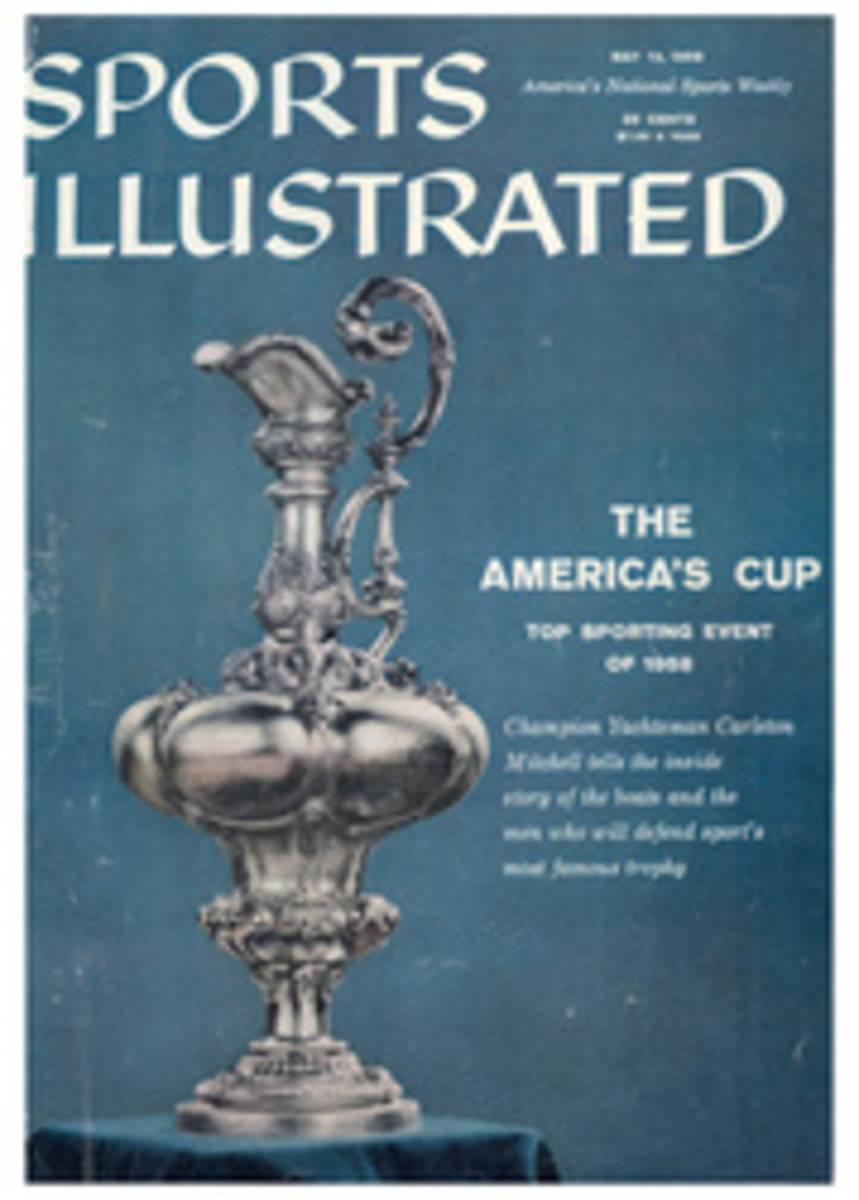
The Doberman pinscher: darling...or devil?
Pictured above is a Doberman pinscher in two of the moods which have earned him a reputation as one of the most controversial breeds in America. To some people, he is an elegant, well-mannered companion of children and a faithful defender of the home. To others, he is an evil-tempered, snarling monster, eager and ready to attack anyone and anything.
There are dozens of authenticated stories to support both attitudes.
•In Dallas last month a father fought off a 75-pound Doberman which viciously attacked and mangled his 5-year-old daughter.
•In Michigan a Doberman found a 3-year-old child lost two days in a forest. The dog sat next to the child and patiently signaled their location to rescuers.
•In New Jersey a former dog trainer in the Army's K-9 Corps says, "Our outfit gave all the Dobermans to the Marines. They were just too vicious to handle."
•In Chicago a Doberman alerted its owners to fire and was credited with saving four lives.
•In Connecticut a veterinarian told the owner of an injured Doberman, "I'll treat him if you strap him to the table."
•In Arizona a runaway stallion kicked and trampled a rancher's 4-year-old son. The child's young Doberman saved his life by fearlessly attacking the horse and driving it off.
Each story adds to the misunderstanding which surrounds the breed. And, depending upon who is telling the story, the Doberman emerges as either a darling or a devil. In truth, he is neither. The Doberman pinscher is a highly specialized breed, superb in the uses for which he was developed, but like most specialists totally unsuited to many of the random tasks he is unfairly asked to perform.
"A Doberman must be trained to absolute obedience, ruled with a firm hand and mastered with unflinching authority," says John Behan who has trained hundreds of Dobermans at his Canine College in West Redding, Connecticut. "He is probably one of the easiest breeds to teach but one of the most difficult to control. An owner who is not unconditionally confident in his own ability to handle the dog under all circumstances should look to another breed. The average Doberman pinscher is too much dog for him.
"The unfortunate thing," Behan adds, "is that so many people use common sense in buying practically everything else but a dog. The neighbor down the street has a Doberman. They see only his sleek, aristocratic looks; but that's often enough to make them decide they want one too. You should see what happens after a Doberman wins a major dog show. Suddenly everyone decides it is fashionable to own one. Then the trouble begins."
Enlightened breeders are the first to agree with John Behan that if the breed is to survive in this country selective selling of Dobermans is every bit as essential as selective breeding. At the present time there are about 39,000 Dobermans in the United States. Of this number, it is not unreasonable to assume that upwards of 30% are in the homes of people who should not own them.
"I had an hysterical call just last week from a woman who was being held at bay by the family pet," Behan relates. "She insisted, against my advice, upon owning a Doberman. She lives in a big country house and wanted protection when her husband was out of town. But she also wanted a pet she could pamper and coddle. She permitted the dog the run of the house with only one taboo: he was forbidden to get on her fancy lace bedspread.
"The dog, a creature of animal, not human, comprehension—a fact too many owners refuse to accept—was unable to distinguish between the bedspread and other furniture. On the occasion of the frantic phone call, the woman had entered her bedroom to find the Doberman on the bed. In anger she rushed at him, and the dog did the only thing he might be expected to do under such circumstances. He went for her."
Behan emphatically points out that the owner, not the dog, was at fault here. A situation had occurred which the dog was unfamiliar with and therefore unable to understand. He reacted instinctively. And finding himself in control of the situation, he took advantage of it. Another breed of dog, it is true, might not have been as quick tempered or as easily aroused by similar provocation. But here the distinctive personality of the Doberman pinscher is involved.
When Herr Louis Dobermann, a German dogcatcher, began about 1870 to experiment with the development of the breed that now bears his name, his goal was a dog with the agility and grace of a terrier, the sleek aristocracy of a racer, the power and strength of a working shepherd and the ferocity of a tiger—ready and willing to attack anything, man or beast.
An indication of Dobermann's success was reported some years later by an early Swiss breeder, Gottfried Liechti, who wrote: "They were certainly robust, had absolutely no trace of fear—not of the devil himself—and it required a good deal of courage to own one." A shortage of courage was obviously no problem in Germany at the turn of the century, because the popularity of "Dobermann's dogs" spread astonishingly throughout the country. By 1912 the Dobermann Pinscher Club of Germany was formed, and the breed had developed an enthusiastic following in several neighboring countries. One fancier, Philipp Gruenig, summed up the ideal of European breeders in describing a particular Doberman: "He was covered with scars, and was the sharpest dog I ever saw." Sharp is an agreeable German way of saying ferocious.
A Floridian who showed his Doberman pinscher at Wiesbaden last September confirmed the sharpness of the German Dobes. "Most of the males were brought in and benched with spike collars," he reported, "and few persons showed inclination to touch them."
In America this sharpness has been bred down but fiery temperament remains characteristic of the breed. It is by no means a weakness. Rather, it is one of the traits which, when properly utilized, makes the Doberman a superb animal for certain specialized duties.
This was proved dramatically in the war. Nominated by the Marine Corps as its official war dog, the "devil dogs," as they were called, performed heroically in several branches of the armed forces.
In periods of a few weeks, these dogs were put through intensive basic training which transformed them from domestic animals to battle-conditioned sentries, messengers, scouts and attack dogs. They were trained to obey to the absolute any order given by their handlers. Upon the command "attack," they became vicious killers, often more feared than firearms. But they learned, too, to share peacefully the intimate and often unpleasant living conditions of the men they served.
One Doberman saved an entire tank platoon on Bougainville by alerting it to an ambush. Another gave his life to take on, singlehanded, a machine gun nest which had already picked off 12 men on an island near Okinawa. By doing so, he was credited with saving the lives of an entire patrol. When the dog's bullet-ridden body was lifted by his buddies from the nest, they had to pry his teeth from the arm of a dead enemy.
On Iwo Jima, Dobermans routed snipers from caves, pillboxes and tunnels. On Peleliu Island they stood security watch through jungle nights, carried messages between outposts and established communications by laying wire from reels strapped to their backs. Several were officially cited for bravery.
In civilian life as well as in wartime the Doberman has distinguished himself as a guard dog. Doberman guards have been used by police departments, colleges, mental institutions, banks, department stores, dozens of small businesses and even saloons where persistent thefts were stopped only when the dogs were introduced.
The Doberman in the pictures above is being trained by John Behan to guard a doctor who has twice been attacked by mental patients. The dog's job will be to sit in the doctor's office as quietly as he is seated with Behan's children. But when the command "get him" is given, this seemingly gentle dog will instantly become a vicious animal ready to kill, if necessary, to protect his owner. His basic attack objective, however, is not to kill but to disarm by first going for the right hand and then bringing the enemy to bay.
In 1952 R. H. Macy & Co. installed in their New York store a team of four Dobermans trained at Behan's Canine College. During store hours, the dogs live in rooftop kennels where they review the exercises necessary to keep them in condition for the jobs they perform at night. When Macy's closes its doors for the day, the dogs are released to roam the many floors of the building, searching for prowlers and sneak thieves, stragglers caught after hours, signs of smoke or fire, water leakage, or anything out of the ordinary. Recently two young girls were reported missing and traced to Macy's vast and darkened merchandise jungle. They were found by a Doberman guard dog who, to the amazement of his handler, licked the girls' hands to put them at ease.
At one time the Doberman was used experimentally as a seeing-eye dog. "He was a pleasure to train," says Lois Meistrell who formerly worked with The Seeing Eye in Morristown, New Jersey. "But he demanded more constant control than was desirable or could be expected from the average blind owner. He was more prone to distraction than several of the other breeds, and sometimes too overprotective of his master. When finally The Seeing Eye decided it was necessary to recall the Dobermans, most people were relieved to send them back.
"There was one blind newsdealer, though, who refused to give up his Doberman. It seems the newsdealer was not among Governor Dewey's fans. Unfortunately for the governor, he often bought his paper at this newsstand. When he did, the dealer sicked the dog on Dewey. He'd never had a guide dog which responded so violently to Republicans and he wasn't about to part with him."
In this case, again, the owner, not the dog, must be blamed.
TWO PHOTOS
TWO PHOTOS
MACY GUARD DOG (above) keeps in shape for department store duties after completing special attack training course at John Behan's Canine College (below).
TWO PHOTOS
TWO MOODS OF DOBERMAN are illustrated here as Kevin and Eileen Behan fondle dog being trained by their father (below left) to attack enemies upon command.

